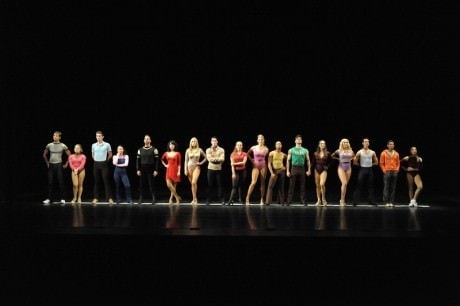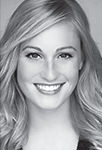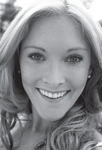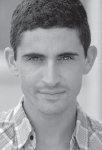Director/Choreographer Stephen Nachamie takes us behind the scenes of Olney Theatre Center’s production of A Chorus Line.’ Here is Part 1.
OLNEY THEATRE CENTER ASKS STEPHEN TO DIRECT AND CHOREOGRAPH A CHORUS LINE

One of my dear friends and early mentors was Director/Choreographer Tony Stevens – who in 1974 had the idea (with Michon Peacock) to start a Dancer’s collective – or theatre company – to keep work and art alive for the Broadway Gypsies of the time. There was less work on Broadway than ever – and at the time there wasn’t the idea of the “megamusical” running forever that there is now (thanks to A Chorus Line, Les Miz, and The Phantom of the Opera). The “Gypsies” were the unsung heroes of the Broadway- the dancers had to be able to perform as singers and actors. Many as well had expertise in direction and design, as well as stage management. Tony and Michon started a rap session and invited director Michael Bennett to be a part of it. That all night session became A Chorus Line. Tony was involved with the project until legendary director/choreographer Bob Fosse asked him to be his assistant on the new musical Chicago in 1975. Tony’s light, love, and joy split between the two shows. Tony had some success directing and choreographing tours, regional shows, films, and TV. What stayed with me and what I learned from him was the ability to enjoy – and find the joy in everything you do. Tony passed away from cancer in July 2011 – still working until the end. I wanted to dedicate my return to A Chorus Line and to dance to his wonderful spirit.
My involvement with A Chorus Line at the Olney actually began a few years ago. Friends continually told me I should push for the show to happen there – and that it would look so wonderful on that huge Olney stage. I had begun my acting and directing careers with A Chorus Line – and spent a number of years of my early career Associate Directing tours or re-creating the staging for regional and stock theatres. The show looks so spare and simple on the surface – when actually it is an amazing undertaking to teach the movement and direct 17-26 principal actors in the same situation and with the same high stakes.
To truly get to the root of what makes this show special time and care is needed in rehearsal: Sometimes producers will only give 6 days to get this large show up – or underestimate the physical and technical requirements for the show. It is also a very hard show to cast because it has so many skill sets needed to pull off the material. A Chorus Line is inherently a play with music about a group of people whose trade is dancing in theatre. You cannot simply put anyone in a costume and pretend that they can inhabit those skills – these need to be very talented highly trained individuals to truly service the play. It is also a play that is about people who are IN the business, not just starting out – so you need some life experience behind the roles. I began at 18 in the show as Mark – but sometimes the show will tour with young performers who have not yet had the life experience or the training to really say something in the roles. It was very important to me in telling our story to have people that brought the truth of the “Broadway Gypsy” life experience.
When Amy Marshall, Chris Youstra, and Jason Loewith approached me about ACL around the holidays last year – I had a wonderful time directing in the DC Community before – but I had directed 1776 (Mainly strong character actors, and singers), Camelot (again the same pool) and Charlie Brown (a completely different pool of skills but mainly sketch comedy and improv minds.) – I honestly did not know the Actor/Singer/Dancer talent pool – and I wondered if we would be able to cast locally. We quickly put out feelers and audition notices – and I was thrilled during our February auditions to find so many amazing local triple threats that I had not yet experienced simply because I wasn’t looking for the dance skills for other shows.
AUDITIONS AND CASTING
We began our auditions by teaching segments of the Ballet and Jazz combinations from the show – and a short technical combination asking for a double pirouette and a time-step. We were looking for dancers with solid technique who were quick to learn. We saw probably 100 people in those three days. From there – I played a bit with the auditionees – getting them relaxed and getting them to talk and play. I wanted to know who these people coming in were – why they loved what they did. They also sang for us and read sides from the show. Sometimes I asked them about their own start dancing or had them paraphrase the story I wanted to see if they could just talk and bring themselves to the material. Perhaps if they knew it, I had them explore it in a different way. I have a great love for the material and the style of the piece – the reason why I connected to it was because acting was always my start. – so the intention of the dance and the words always intrigued and inspired me.

I was thrilled to re-explore this side of Parker Drown – I have always been a great fan of his acting and singing. I also was thrilled to meet Sam Edgerly (who had studied at American University with a teaching colleague of mine), Kyle Schliefer – who sort of “grew up” in shows at the Olney – and Jen Cordiner (yes, a great triple threat and a Rockette), and Heidi Kershaw among others. After our February auditions, I was very inspired.
I began to look at the play again from the published copy – so that I could see the words without seeing decades of notes I had written and been give on the show. I also was very happy to have some time away from the A Chorus Line “industry” and to have some life experience as a director/writer and artist on my own terms. I began to look for actors and colleagues I had worked with that I really thought had something to say about this story and this life and these roles. I also began to think of performers that I had really wanted to work with again or for the first time. – like Carl Randolph (whom I had worked with in 1776) – Bryan Knowlton – who I had met in 2003 when I was directing a company of Chicago in NH – and he joined the last company of A Chorus Line I directed (Fran Liebergall – Marvin Hamslich’s assistant through all his shows and Broadway Musical Supervisor for ACL was my Musical Director). Back then Bryan seemed too young to really get “Paul’s story” at the time – he played “Mark” for me in that company- I have watched him grow as an artist and choreographer in his own right. He took over “Paul” on Broadway in 2006, and I am thrilled to get to re-explore the role again with him now. I had also known and been watching Michelle Aravena’s work over the years – As she covered Fantine In Les Miz, or commanding the stage touring as “Anita” in West Side Story – and I thought, “I want to work with her and need to find the right opportunity.” Michelle was originally going to be Diana and cover Cassie – and due to a last minute cast change – she fearlessly stepped right into Cassie, and I was thrilled to get to explore something very new for both of us and find her story in this. Jaimie Kelton had always mentioned ACL to me – we have worked on so many other wonderful and different piece such as Charlie Brown, Urinetown, and Spelling Bee together – I heard a voice in Jaimie that after 8 years of collaboration I had heard and that inspired me to cast her as Maggie.
We had a large 3-day audition in NYC – seeing about 500 people over three days. The Equity calls have a sign up and a protocal to how they are run and how many people we have to see in groups. My assistant Ra-Sean Holloway and I taught even shorter combinations and kept running through groups of 20 men or women at a time to teach them and then dance them in groups of fours – after all had danced we sang them through 16 bars. On the open – non-equity days – we had to move even faster seeing groups of 30 or 35 just to get through everyone. There were so many people who signed up to be seen we had to close the audition! It was kind of like a game show to get through that many – but we did not gloss over anyone and really looked for the roles we needed to fill and the skills we needed. Several people had auditioned from other companies of the show – some were able to take notes along with my ideas, but some weren’t as easily adaptable to new thoughts on the piece.
The casting of the piece continued for several months as I was directing other pieces. Some roles are very tricky to fill – and others needed to be replaced.
Our first rehearsal consisted of a “meet and greet” and readthrough of the script – the cast was put in “line” order around the table. I wanted to hear (as well as the cast to hear) the dialogue of the show and wonderful lyrics without any pressure: to just talk and listen. I wanted the cast to hear the story before they got on their feet.
I had not heard those words just spoken in ages – I had been away from the show as well for ten years. It really hit me that this play brilliantly wove people’s stories and oral histories into a powerful work of theatre that tells the story of a Dancer (and Theatre Artist’s) life. I was also curious about this company of people assembled for the Olney – as I asked each cast member what their inspiration to Dance was, What the first Broadway show they saw was, how old they were when they started taking classes, and what their dream in this business is. The answers were all pretty diverse in age, dreams, and inspirations – but one thing that was clear – everyone in that room was burning to dance and perform, and they all felt at home in that world. In the cast were also some people that I had always admired and knew from class and auditions (Steven Sofia, Bryan Knowlton), and others that I had worked with but realized I didn’t know a lot about. I also told my story of burning to train and needing to find out how theatre worked. I also had one on one meetings with everyone in the cast to discuss the roots and “backstory”of their characters. We talked about who they know and don’t know at this audition, who their competition is and what their stakes are. From day one we started to build full 360 degree humans for the line.
There were several tricky parts of revisiting the material -beginning with change in outlook in 2013, and also the changes in training in all disciplines. In 1975, these “Broadway gypsies” onstage were talking frankly and unapologetically about issues like body enhancement and homosexuality. In 1975, that was a bit shocking and revolutionary. My good friend (and Italian theatre star and Cassie) Maria Laura-Baccarini pointed out to me last year, after seeing the revival in Italy, that “The show comes from a time when these people were not asked to talk- so no one knew these things. Now no one will shut up!” The stakes and the time period had to come into play for my actors – so that the importance of revealing secrets would come through.
Michael Bennett’s choreography is very low to the ground, very cool, and very go-go/disco/funky. It is loose – and all connected to acting intentions. Today’s choreography is less subtle, more percussive, and very lifted. In the last 38 years we have learned to see in visual “bytes” and hear in sound “bytes” and we aren’t accustomed to learning phrases that require more presence and attention spans… (We have an app for that now).
Teaching the style was of utmost importance to me as this choreography not only sets time and place for the show – but also it IS a text – and every movement is tied to the scene and acting intentions. Vocal stylings have changed in the last few decades. A Chorus Line was originally orchestrated (by many) and Vocally arranged (by Don Pippin) to go subtly from speech to song, and lie in the character’s speaking ranges. In 2013, most musical theatre is geared towards singers working at the top of their ranges and constantly hitting the top. This cast had to be taught that these are not “trained singers” of their time – that this too is a text – where the lyric and emotion are of utmost importance. Again… subtlety and simplicity are the key to exploring the texts of this show. I had the pleasure in the past of closely working with Fran Liebergall (Marvin Hamlisch’s assistant) on the show. She was able to explain why the show was composed as it was and the tension in the music. It was fun to re-explore the text with all of that knowledge. I had also forgotten how much information there is to get out in the show – traffic, intentions, relationships, for 24 people! Once they were on their feet I could finally begin to hone and tweak and focus as a director.
REHEARSALS
Getting into rehearsal – I questioned if I would be able to keep up with this cast. I had retired from performing in 2002 to concentrate on directing and writing. While directing a show in Maine in 2007, I was in an automobile accident that affected my neck, back and spine. I was told by the orthopedist I was sent to that I would not regain mobility and probably not be able dance up to speed again. I had continued to work with constrictions and with pain and oddly in the winter of 2012, my doctor introduced me to a wonderful Physical Therapist – who mainly focused on rehabilitating dancers from injury. I began work with him in November – and by the spring of 2013 – I had good news. – I had 75 percent of mobility returned … I would be able to dance again with my company of ACL! Careful warmups and excersizes and PT brought me back to a place of movement and joy that I had not been able to enjoy in years….and after four weeks of rehearsal with this wonderful cast – I’m still in good shape!

On our feet, I watched the relationships of the characters and cast grow – and encouraged certain cast members to explore. As we got closer to performance, I began to edit more and more – as with 17 people always in view – the audience’s eye needs to be clearly guided to certain behaviors and parts of the story. I also wanted to make sure that no matter where the audience looked, they were always seeing someone’s stakes and life on that line. I wanted the cast to be present and find their “thought process” through this audition rather than “staging” their lives – I wanted them to live them.
REHEARSAL STORIES

A few rehearsal stories: I had great fun getting a clean look into the material with those who had not yet been around the show. Colleen Hayes began rehearsal sort of shy and guarded around me – wanting to be “right” as Sheila. Many have the impression that “Sheila” is a bitch or cold – I am not sure where that came from. She is a strong woman who is a professional and has spent a long time in the business. We had a lot of fun finding HER Sheila through constant play and improvisation, editing and some serious silliness on all of our parts. Sheila needs to have a “tug of war” for power with her old friend and now director “Zach.” She knows things about him the rest don’t and she adores him so we had to set that base, and then find the colors of when Zach pushes her to tell about her painful childhood honestly to the line. It was really wonderful to watch this actress find new things and trust and take really courageous chances with the role – and let her silliness and vulnerability shine through.
MICHELLE, BRYAN, AND JEN

Michelle Aravena moved from “Diana” to “Cassie” a little over a week before we opened – it was such a joy to take a look at her “Cassie” dynamic after meeting her in the rehearsal studio as “Diana.” She is a daring, honest, and heartfelt actress and artist – so every line, vocal and step comes from working from the core of the scene. We really had some very honest and grounded rehearsals looking at what Cassie’s journey is and what having the clarity and courage to stake your claim on a “second chance” means. She was able to access and play with Cassie’s heart, sensuality, and fight for what she needs, and always add another color to her canvas each day.

Jen Cordiner had covered “Val” previously, and it we had a fun silly time setting where HER sense of humor sat with this character – it was now hers!
Bryan Knowlton (who also assisted me on staging the production – and maintains the choreography) and I had worked together in 2003, – then he was “Mark” – and since then he has played “Paul” on Broadway. We both have had the great fortune of being able to portray that character onstage – and it was nice to be able to look at this journey from a different perspective.

I was able to explore it from the text and finding new stakes for “Paul” – Bryan and I had many weeks of discussions of what the story meant to us – and more importantly to him. We played with different levels and inner objects in this piece – we are both very proud to see a very different “Paul” than either of us had explored before. It was very exciting and vulnerable in that rehearsal studio – he is pretty special.
THE UNDERSTUDIES
The understudies for A Chorus Line have to be at rehearsal from day one – there is simply too much material they have to learn – and they all have to learn it for multiple roles (for some up to 3 or 4!). There was one final run-through in the studio – where many things had to be accomplished – so several members of the cast had to be pulled to try on costumes, shoes, get physical therapy. During this run the “swings” all stepped into the roles that were missing. I was so happy and impressed to see a near seamless rehearsal – to see Taylor play Maggie and Connie – Christie – as Diana, Carl as Don, and Jay as Richie. It was pretty exciting to see that even though the rehearsals usually focus on “the line” that the swings were keeping up to speed and ready to embody any of the roles they cover. Very proud!
THE OLNEY SPACE
The Olney is a very unique space – as the Orchestra section is built as a three-quarter thrust audience. (Meaning that on a show staged for a “proscenium” theatre – no two seats have the same view). When we stepped into the theatre I had to check the “sightlines” for every seat and constantly adjust moments – so that every seat could see the action needed.
A Chorus Line is a high stakes piece that is played with a lot of honesty, so it always has to be truthful – meaning that it will always be a little different every night if every actor is in the moment and listening and trying to get that job. What I learned by spending time creating new works and material and then returning to ACL is that there is no ‘right or wrong’ with this piece only the truth – which was Michael Bennett’s ideal with all his work. If as a director or an audience member I can see the actor’s mind or comment over the character’s – there needs to be a refocusing of that performance. The structure of the Original A Chorus Line really kind of struck me all over again working on it – that not a moment draws you away from the story or the actor. In 1975 Michael Bennett led the creative time in creating a PLAY – not a musical – so every bit of underscoring breathes with the actor and the moment- the switch from speech to song is very subtle. Dance is not pure entertainment in this show – but another text to be acted – movement comes out of the reality of the piece and is the story or tells the story.
In the last 38 years – A Chorus Line has kind of become like Rashomon – everyone who was involved with it or recreates it has their own perception from their perspective of being IN it or involved. Some stage it merely from a movement base – putting up the moves of other actors they have worked with before – so in some productions – it can become more like a game of “telephone” of what the play should be than just exploring the play again. Revisiting really showed me that with my classical acting background, as well as being a part of this world – and having much more life experience of the business gave me a stronger understanding of the piece and the story it tells. It was very nice and freeing to be able to find behavior and movement for this piece from the actors, situation, and the purity of the words in the script. I got to learn something new about every character through the actor I cast in the role – that was so much more exciting to me and to the production than saying “OK – it goes like this … 5-6-7-8!”
Rehearsing the show in a studio is much more intimate that seeing it in the theatre. Getting some distance from the action really took my eye to how much information there is given to the audience at any one time, and how aware actors need to be of that. The beauty of this show – is that everyone is always on the line. There is nowhere to hide, and the audience then can relate to them – and become Zach’s eyes as he runs the audition. The audience lives in that limbo between rooting for their heroes onstage and realizing or perhaps learning that yes, we all do this for LOVE of what we do – but when we cut to the chase – it is still a business. Decisions on who makes it or who gets the job – for the most part are not personal at all – but cut and dry decisions made upon who fits a skill set, a look and who can bring something unique – but perhaps not TOO unique to a production. Several stunning performers have been let go from Broadway shows out of town and replaced for “outshining the star.”
PREVIEWS
The preview period and opening night for the show were very exciting for me. I stress to the actors that for them and for us to truly invest in the play – that “there is no audience.” So it was thrilling for me to watch a new group of people see this event with clear eyes and open ears. The piece is not constructed to give the audience a chance to applaud for every little thing the performers do – but rather the audience is sometimes withheld from that release. They are put in the situation of the audition – and it was eye-opening to see what they saw as ‘fair or not fair’ as the play went on. The finale is not a bow or curtain call – it is the epilogue – where everyone you have met for the last two hours becomes a nameless, faceless, chorus line. They fade into nothing at the end and when the lights come up they are gone and the theatre is empty. This was Bennett’s comment on the tragedy of it all of what the job is, and that even though we are special, we are all just a part of something – not the whole experience.
OPENING NIGHT

The opening night audience shot to their feet and launched into a standing ovation as the cast was performing the “Rockette” kicks at the end of the finale – the crowd was trying to egg on the cast to take a bow. The tragedy of that final moment of the piece really struck me that night. That this is not a normal show – but this is a play with the power to resonate deeply with the audience. I hear that in some recent productions a final “bow” was added which I find against the point of the piece. A Chorus Line is the anti-musical in a way – it spends the whole show showing you who the cast “really is” – so I liken the whole play to what the audience thinks of as a “curtain call” – the epilogue – the finale is really what we are used to seeing as a performance.
I was so proud of this cast – most of whom had actually never done or seen the show before we began. This experience is now theirs. I am still on the line with them in spirit – but in a way with this production – I saw how I had moved onto exploring new works and the excitement of putting that perspective into my work on this “old friend. i saw many many new things I had not seen before or understood as deeply in the material. I am also thrilled that this show has a life and can be unique for each audience that comes to see it! There have been a few A Chorus Line fans who stopped me in the lobby to tell me what they saw that was new for them. hope many new eyes and ears get to experience this show. The cast brings its own joy to every performance. I could not ask for more.
A Chorus Line plays through September 8, 2013 on the Main Stage at Olney Theatre Center— 2001 Olney-Sandy Spring Road, in Olney, MD. For tickets, call (301) 924-3400, or purchase them online. Running Time is approximately two hours, with no intermission.
LINKS
Stephen Nachamie’s website.
Meet the cast of Olney Theatre Center’s A Chorus Line.
Amanda Gunther’s review of A Chorus Line.





